-
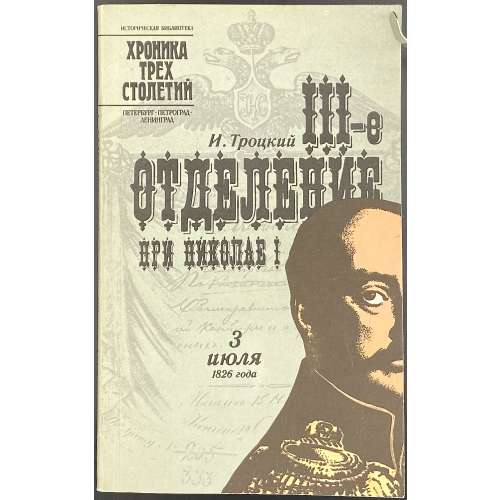 Front wrapper: Историческая библиотека | Хроника трех столетий | Петербург – Петроград – Ленинград | И. Троцкий | III-е Отделение при Николае I | 3 | июля | 1826 года || Title: И. Троцкий | III-е Отделение при Николае I || Faux title (p. 75) : Жизнь | Шервуда-Верного || Pagination: [1-5] 6-317 [3]; 320 pages. Collation: 16mo; [1]16 2-1016; 160 leaves. Binding: Softcover, original pictorial wrappers. Print run: 150,000 copies. Contributors: Исаак Моисеевич Троцкий (Russian-Jewish, 1903 – 1937) – author of the text. Яков Аркадьевич Гордин (Russian-Jewish, b. 1935) – foreword, preparation.
Front wrapper: Историческая библиотека | Хроника трех столетий | Петербург – Петроград – Ленинград | И. Троцкий | III-е Отделение при Николае I | 3 | июля | 1826 года || Title: И. Троцкий | III-е Отделение при Николае I || Faux title (p. 75) : Жизнь | Шервуда-Верного || Pagination: [1-5] 6-317 [3]; 320 pages. Collation: 16mo; [1]16 2-1016; 160 leaves. Binding: Softcover, original pictorial wrappers. Print run: 150,000 copies. Contributors: Исаак Моисеевич Троцкий (Russian-Jewish, 1903 – 1937) – author of the text. Яков Аркадьевич Гордин (Russian-Jewish, b. 1935) – foreword, preparation. -
![Owen E. Holloway. French Rococo Book Illustration. – London: Alec Tiranti, 1969. – pp.: ffl [2 blanks] [i-iv] v-vi, 1-283, bfl.](https://varshavskycollection.com/wp-content/uploads/2021/02/LIB-2526.2020-d-500x500.jpeg) Title page (in red and black): FRENCH ROCOCO | BOOK ILLUSTRATION | OWEN E. HOLLOWAY | {vignette} | LONDON/ALEC TIRANTI/1969 || Series: Pagination: [2 blanks], [i-iv] v-vi, 1-115 [116 blank], plus 65 leaves of plates (283 illustrations). Binding: 25.5 x 19 cm; publisher's navy buckram, gilt lettering to spine, pictorial dust jacket, unclipped.
Title page (in red and black): FRENCH ROCOCO | BOOK ILLUSTRATION | OWEN E. HOLLOWAY | {vignette} | LONDON/ALEC TIRANTI/1969 || Series: Pagination: [2 blanks], [i-iv] v-vi, 1-115 [116 blank], plus 65 leaves of plates (283 illustrations). Binding: 25.5 x 19 cm; publisher's navy buckram, gilt lettering to spine, pictorial dust jacket, unclipped. -
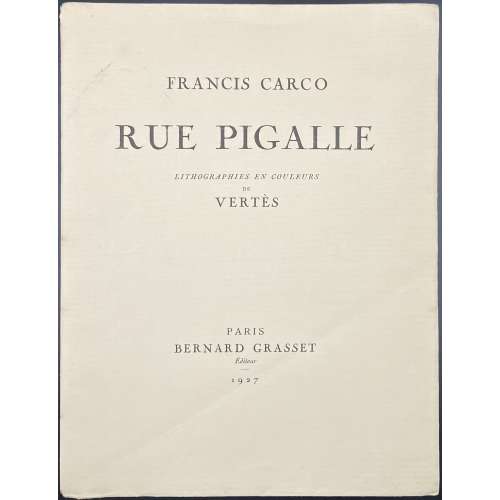 Title-page: FRANCIS CARCO | RUE PIGALLE | LITHOGRAPHIES EN COULEURS | DE | VERTÈS | PARIS | BERNARD GRASSET | Éditeur | 1927 || Description: 25.7 x 19.5 cm, French flapped cream wrappers with black lettering similar to title, lettering to spine, [2] 1st blank leaf, [2] h.t. / blank, plate / blank, [2] t.p. /blank, dedication “A | FRED ANTOINE ANGERMAYER” / blank, [1-2] d.t.p. “CHAPITRE | PREMIER” / blank, [3] 4-124, [2] limitation / blank, [2] last blank leaf; collation: 4to; π4 1-164; total 68 leaves and 14 plates printed by Frères Mourlot after watercolours by Marcel Vertès. Printing : September 15, 1927 by Coulouma in Argenteuil (H. Barthélemy, director); plates printed by Frères Mourlot in Paris; Edition: print run limited to 338 copies of which 22 on Japon Impérial (numbered Japon 1-15 and I-VII) enriched with one original watercolour drawing, one suite in black and one in colour, etc.; 43 copies on Hollande van Gelder (Hollande 1-33 and I-X) with additional suites in black and in colour; 270 copies on Vélin d’Arches (Arches 1-250 and I-XX); and 3 “special” copies. This copy is numbered Arches № 162. Contributors: Francis Carco [François Carcopino-Tusoli] (French, 1886 – 1958) – author. Marcel Vertès [Marcell Vértes] (Jewish-Hungarian-French, 1895 – 1961) – artist. Frères Mourlot – lithographer. Robert Coulouma (French, 1887 – 1976) – printer. Bernard Grasset (French, 1881 – 1955) – publisher. Fred Antoine Angermayer (German, 1889 –1951) – dedicatee. Other names: Marcel Vertès, Marcel Vertes, Marcell Vértes
Title-page: FRANCIS CARCO | RUE PIGALLE | LITHOGRAPHIES EN COULEURS | DE | VERTÈS | PARIS | BERNARD GRASSET | Éditeur | 1927 || Description: 25.7 x 19.5 cm, French flapped cream wrappers with black lettering similar to title, lettering to spine, [2] 1st blank leaf, [2] h.t. / blank, plate / blank, [2] t.p. /blank, dedication “A | FRED ANTOINE ANGERMAYER” / blank, [1-2] d.t.p. “CHAPITRE | PREMIER” / blank, [3] 4-124, [2] limitation / blank, [2] last blank leaf; collation: 4to; π4 1-164; total 68 leaves and 14 plates printed by Frères Mourlot after watercolours by Marcel Vertès. Printing : September 15, 1927 by Coulouma in Argenteuil (H. Barthélemy, director); plates printed by Frères Mourlot in Paris; Edition: print run limited to 338 copies of which 22 on Japon Impérial (numbered Japon 1-15 and I-VII) enriched with one original watercolour drawing, one suite in black and one in colour, etc.; 43 copies on Hollande van Gelder (Hollande 1-33 and I-X) with additional suites in black and in colour; 270 copies on Vélin d’Arches (Arches 1-250 and I-XX); and 3 “special” copies. This copy is numbered Arches № 162. Contributors: Francis Carco [François Carcopino-Tusoli] (French, 1886 – 1958) – author. Marcel Vertès [Marcell Vértes] (Jewish-Hungarian-French, 1895 – 1961) – artist. Frères Mourlot – lithographer. Robert Coulouma (French, 1887 – 1976) – printer. Bernard Grasset (French, 1881 – 1955) – publisher. Fred Antoine Angermayer (German, 1889 –1951) – dedicatee. Other names: Marcel Vertès, Marcel Vertes, Marcell Vértes -
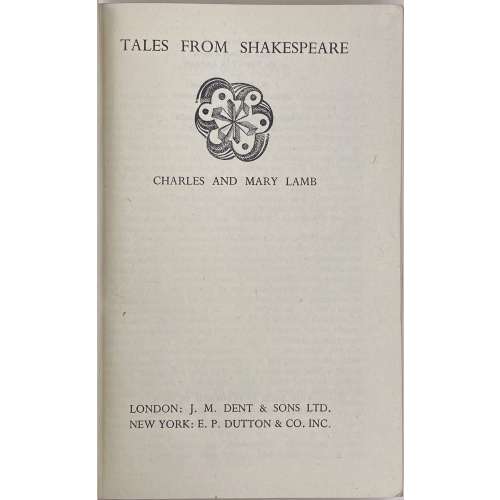 Description: 17.4 x 11 cm, blue publisher’s cloth, blind device to front board, gilt lettering to spine, no DJ, pink abstract diaper endpapers, owner’s ink inscription to ffep, dated June 28, 1945. Serial t.p.: Everyman, I will go with thee, and be thy guide, | In thy most need to go by the side. | — | EVERYMAN'S LIBRARY | EDITED BY ERNEST RHYS | No. 8 | FOR YOUNG PEOPLE | TALES FROM SHAKESPEARE | BY CHARLES AND MARY LAMB | ILLUSTRATIONS BY ARTHUR | RACKHAM || Title-page: TALES FROM SHAKESPEARE | {device} | CHARLES AND MARY LAMB | LONDON: J. M. DENT & SONS LTD. | NEW YORK: E. P. DUTTON & CO. INC. || T.p verso: All rights reserved | Made in Great Britain | at The Temple Press Letchworth | for | J. M. Dent & Sons Ltd. | Aldine House Bedford St. London | First published 1807 | First published in this edition 1906 | Last reprint (reset) 1944 | [blank] | THIS BOOK IS PRODUCED IN COM- | PLETE CONFORMITY WITH THE | AUTHORIZED ECONOMY STANDARDS || Collation: 16mo; [A]-K16; total 160 leaves, 9 full-page illustrations after Arthur Rackham, within collation (text on the other side). Pagination: [i-iv] v-viii, 1-312, total 320 pages, ils. Contributors: William Shakespeare (English, 1564 – 1616) Mary Ann Lamb (British, 1764 – 1847) – author. Charles Lamb (British, 1775 – 1834) – author. Ernest Percival Rhys (British, 1859 – 1946) – editor. Arthur Rackham (British, 1867 – 1939) – artist.
Description: 17.4 x 11 cm, blue publisher’s cloth, blind device to front board, gilt lettering to spine, no DJ, pink abstract diaper endpapers, owner’s ink inscription to ffep, dated June 28, 1945. Serial t.p.: Everyman, I will go with thee, and be thy guide, | In thy most need to go by the side. | — | EVERYMAN'S LIBRARY | EDITED BY ERNEST RHYS | No. 8 | FOR YOUNG PEOPLE | TALES FROM SHAKESPEARE | BY CHARLES AND MARY LAMB | ILLUSTRATIONS BY ARTHUR | RACKHAM || Title-page: TALES FROM SHAKESPEARE | {device} | CHARLES AND MARY LAMB | LONDON: J. M. DENT & SONS LTD. | NEW YORK: E. P. DUTTON & CO. INC. || T.p verso: All rights reserved | Made in Great Britain | at The Temple Press Letchworth | for | J. M. Dent & Sons Ltd. | Aldine House Bedford St. London | First published 1807 | First published in this edition 1906 | Last reprint (reset) 1944 | [blank] | THIS BOOK IS PRODUCED IN COM- | PLETE CONFORMITY WITH THE | AUTHORIZED ECONOMY STANDARDS || Collation: 16mo; [A]-K16; total 160 leaves, 9 full-page illustrations after Arthur Rackham, within collation (text on the other side). Pagination: [i-iv] v-viii, 1-312, total 320 pages, ils. Contributors: William Shakespeare (English, 1564 – 1616) Mary Ann Lamb (British, 1764 – 1847) – author. Charles Lamb (British, 1775 – 1834) – author. Ernest Percival Rhys (British, 1859 – 1946) – editor. Arthur Rackham (British, 1867 – 1939) – artist.Temple Press, Letchworth, England – printer.
Joseph Malaby Dent (British, 1849 – 1926) – publisher. Note: “On the writing desk were two books – identical copies of Lamb’s Tales From Shakespeare. […] — Why did you choose Lamb? — It was the only book I could find in duplicate except Uncle Tom’s Cabin…” Graham Greene. Our Man in Havana. -
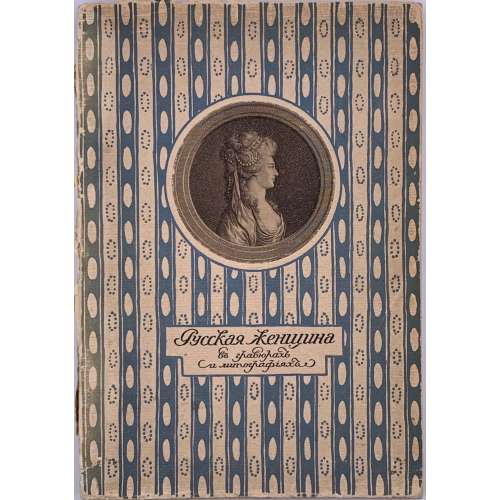 Description: Softcover volume in publisher’s pictorial wrappers, with a b/w medallion portrait and lettering in a frame over geometrical pattern in blue to front; 23 x 16.3 cm, collated 8vo. Title-page: РУССКАЯ ЖЕНЩИНА | ВЪ | ГРАВЮРАХЪ И ЛИТОГРАФIЯХЪ | – | ВЫСТАВКА ПОРТРЕТОВЪ | – | КРУЖОКЪ ЛЮБИТЕЛЕЙ | РУССКИХЪ ИЗЯЩНЫХЪ ИЗДАНIЙ | 1911 || Collation: 1-48, last blank, total 32 leaves plus 15 plates (collotype reproductions) with tissue guards, incl. frontispiece, and a few headpieces; catalogue with 180 entries. Pagination: [1-6] 7-63 [64] [2], total 64 pages, ils. Incl. article "Русская женщина в искусстве" барона Н. Н. Врангеля. Барон Николай Николаевич Врангель (Russian, 1880 – 1915)
Description: Softcover volume in publisher’s pictorial wrappers, with a b/w medallion portrait and lettering in a frame over geometrical pattern in blue to front; 23 x 16.3 cm, collated 8vo. Title-page: РУССКАЯ ЖЕНЩИНА | ВЪ | ГРАВЮРАХЪ И ЛИТОГРАФIЯХЪ | – | ВЫСТАВКА ПОРТРЕТОВЪ | – | КРУЖОКЪ ЛЮБИТЕЛЕЙ | РУССКИХЪ ИЗЯЩНЫХЪ ИЗДАНIЙ | 1911 || Collation: 1-48, last blank, total 32 leaves plus 15 plates (collotype reproductions) with tissue guards, incl. frontispiece, and a few headpieces; catalogue with 180 entries. Pagination: [1-6] 7-63 [64] [2], total 64 pages, ils. Incl. article "Русская женщина в искусстве" барона Н. Н. Врангеля. Барон Николай Николаевич Врангель (Russian, 1880 – 1915) -
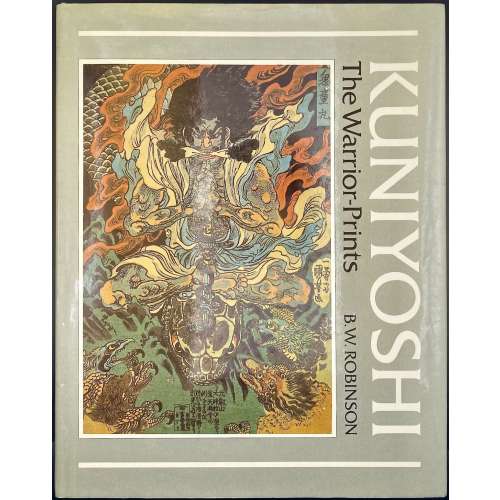 Title-page: KUNIYOSHI | The Warrior-Prints | B. W. Robinson | [space] | PHAIDON | OXFORD || Description: hardcover, 31.7 x 25 cm, bound in olive green cloth with gilt lettering to spine, white endpapers, pictorial olive dust jacket; pp.: [1-6] 7-208 incl. frontispiece, 64 plates, and 30 figs. in the text (total 104 leaves, 205 illustrations, including 32 in colour); catalogue with the list of illustrations, and index of characters portrayed. Inset: A.L.s. on Phaidon letterhead by Sue Moulton; ISBN 0714822272. Edition: 1st edition,1st printing (a review copy). Contributor: Robinson, Basil William (British, 1912 – 2005).
Title-page: KUNIYOSHI | The Warrior-Prints | B. W. Robinson | [space] | PHAIDON | OXFORD || Description: hardcover, 31.7 x 25 cm, bound in olive green cloth with gilt lettering to spine, white endpapers, pictorial olive dust jacket; pp.: [1-6] 7-208 incl. frontispiece, 64 plates, and 30 figs. in the text (total 104 leaves, 205 illustrations, including 32 in colour); catalogue with the list of illustrations, and index of characters portrayed. Inset: A.L.s. on Phaidon letterhead by Sue Moulton; ISBN 0714822272. Edition: 1st edition,1st printing (a review copy). Contributor: Robinson, Basil William (British, 1912 – 2005). -
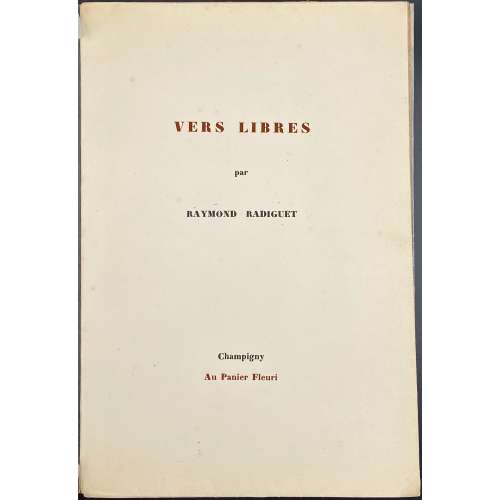 Description: Softcover, 28.5 x 19.5 cm, printed on laid paper watermarked “VAN GELDER ZONEN”, publisher’s original flapped cream wrappers, bookplate of J.-P. Dutel to first blank leaf, 17 leaves within the wrappers, unpaginated, plus three anonymous gouache plates, frontispiece watercolour to h.t. verso, watercolour vignette and ribbons to t.p., attributed by J.-P. Dutel to Jean Laprade (not found). Front wrapper (no vignette): VERS LIBRES | par | RAYMOND RADIGUET | Champigny | Au Panier Fleuri || Half-title: VERS LIBRES (no vignette) Half-title verso: watercolour vignette, lettered in script at the bottom: “Au ciel des Plages | Virginie….” Title-page (red and black): {ribbon} | VERS LIBRES | par | RAYMOND RADIGUET | {vignette} | Champigny | Au Panier Fleuri | {ribbon} || Edition: Limited edition of 125 copies, of which this is copy № 125. The first edition illustrated by Rojan (Feodor Rojankovsky) [LIB-2830.2021] did not state the paper maker, however, the paper is watermarked Arches. This copy is unique, lacking Rojan’s illustrations and enriched with watercolours and gouaches by anonymous artists. Later edition (1937) in this collection: LIB-2827.2021. Contributors: Raymond Radiguet (French, 1903 – 1923) – author. Description by the seller: RADIGUET Raymond. VERS LIBRES. Champigny. Au Panier Fleuri. [Paris, ca 1935]. In-8 broché. Première édition illustrée de 28 superbes compositions en couleurs par Feodor Rojankovsky dit Rojan. Tirage : 125 ex. sur vélin d’Arches. UN DES 125 EXEMPLAIRES SUR VÉLIN D’ARCHES. Exemplaire unique orné de 2 aquarelles originales dans le texte, non signées mais de Jean Laprade et enrichi de 3 gouaches anonymes hors-texte.
Description: Softcover, 28.5 x 19.5 cm, printed on laid paper watermarked “VAN GELDER ZONEN”, publisher’s original flapped cream wrappers, bookplate of J.-P. Dutel to first blank leaf, 17 leaves within the wrappers, unpaginated, plus three anonymous gouache plates, frontispiece watercolour to h.t. verso, watercolour vignette and ribbons to t.p., attributed by J.-P. Dutel to Jean Laprade (not found). Front wrapper (no vignette): VERS LIBRES | par | RAYMOND RADIGUET | Champigny | Au Panier Fleuri || Half-title: VERS LIBRES (no vignette) Half-title verso: watercolour vignette, lettered in script at the bottom: “Au ciel des Plages | Virginie….” Title-page (red and black): {ribbon} | VERS LIBRES | par | RAYMOND RADIGUET | {vignette} | Champigny | Au Panier Fleuri | {ribbon} || Edition: Limited edition of 125 copies, of which this is copy № 125. The first edition illustrated by Rojan (Feodor Rojankovsky) [LIB-2830.2021] did not state the paper maker, however, the paper is watermarked Arches. This copy is unique, lacking Rojan’s illustrations and enriched with watercolours and gouaches by anonymous artists. Later edition (1937) in this collection: LIB-2827.2021. Contributors: Raymond Radiguet (French, 1903 – 1923) – author. Description by the seller: RADIGUET Raymond. VERS LIBRES. Champigny. Au Panier Fleuri. [Paris, ca 1935]. In-8 broché. Première édition illustrée de 28 superbes compositions en couleurs par Feodor Rojankovsky dit Rojan. Tirage : 125 ex. sur vélin d’Arches. UN DES 125 EXEMPLAIRES SUR VÉLIN D’ARCHES. Exemplaire unique orné de 2 aquarelles originales dans le texte, non signées mais de Jean Laprade et enrichi de 3 gouaches anonymes hors-texte.1935 Rojan 1935 Anonym 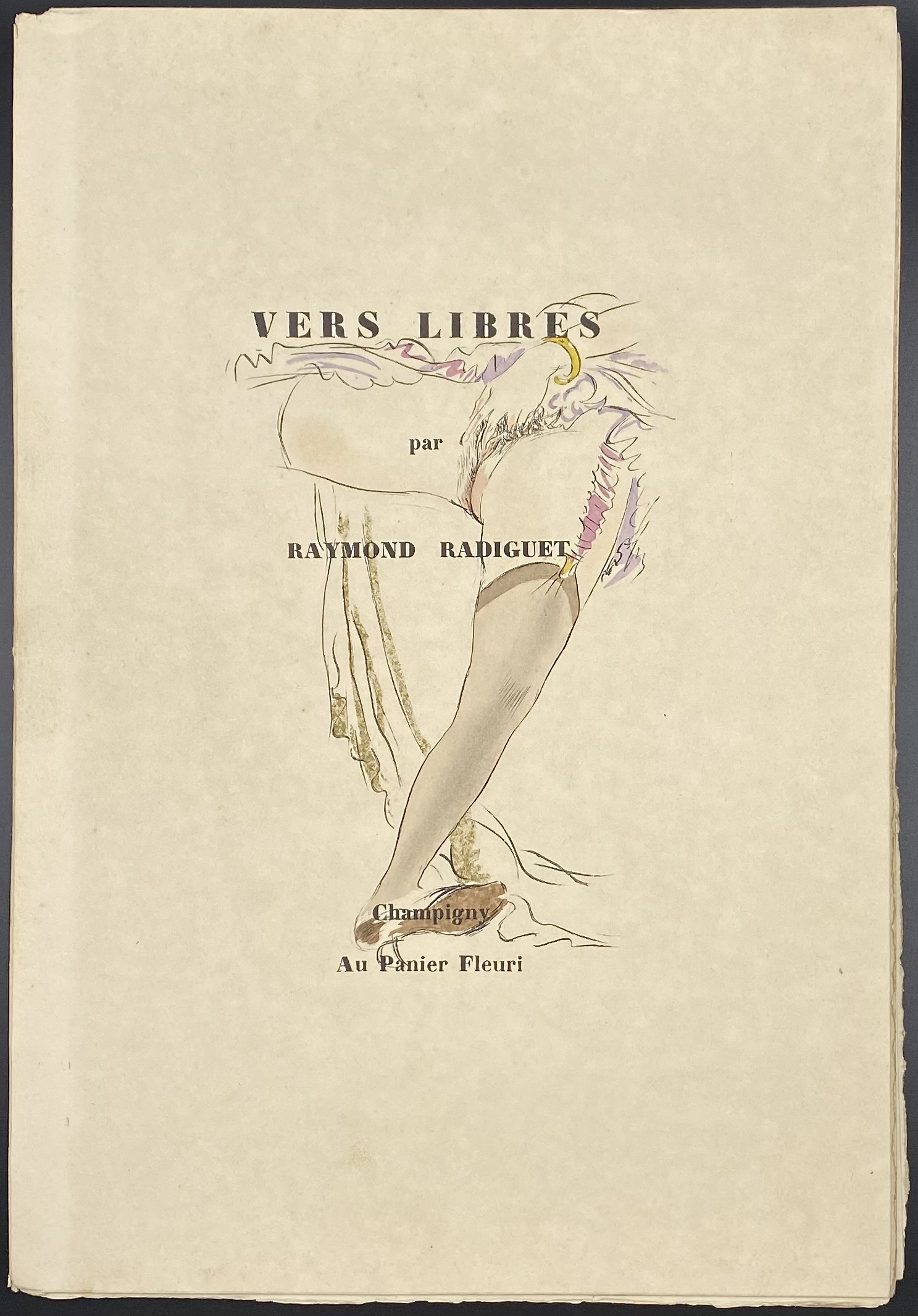
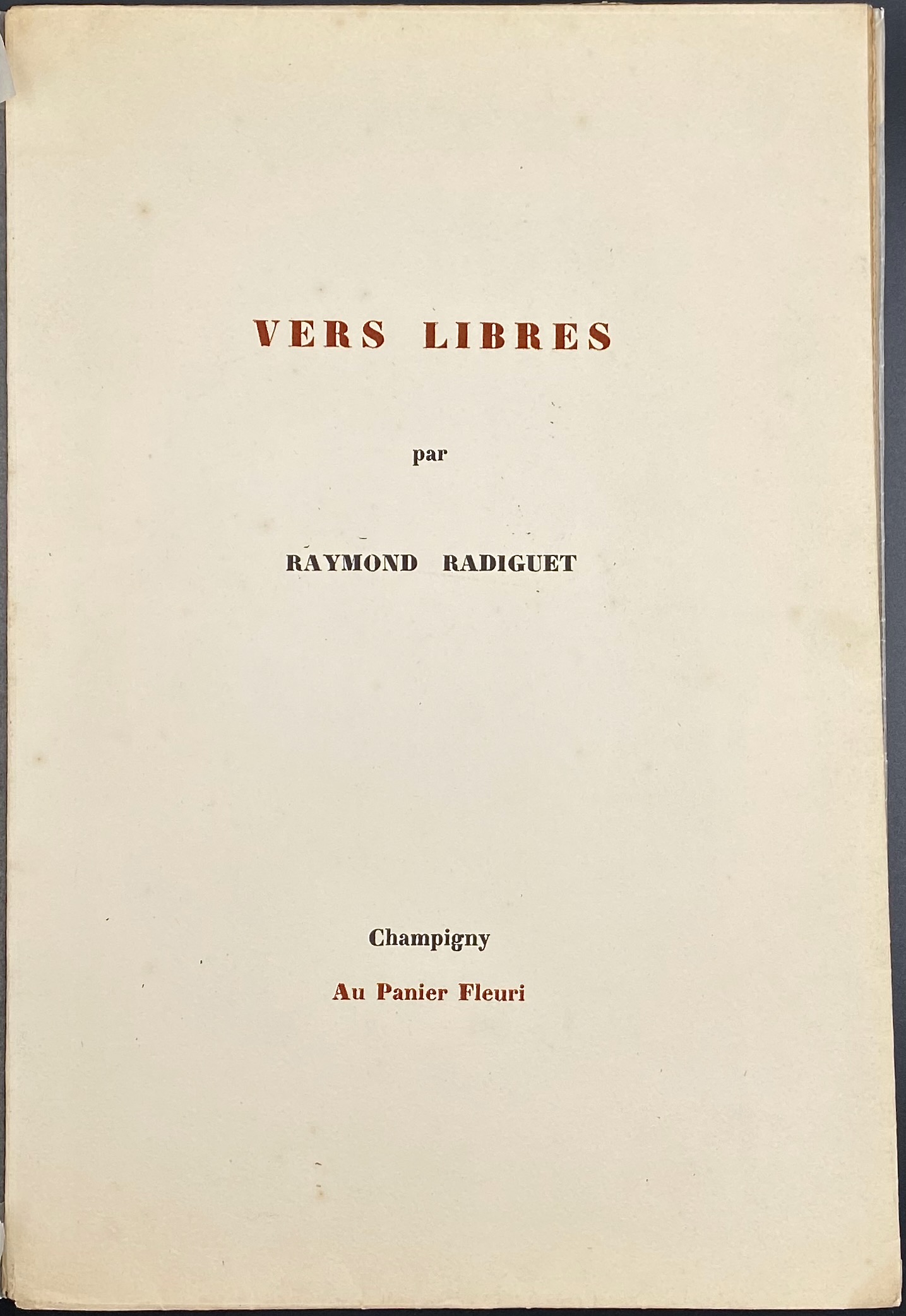
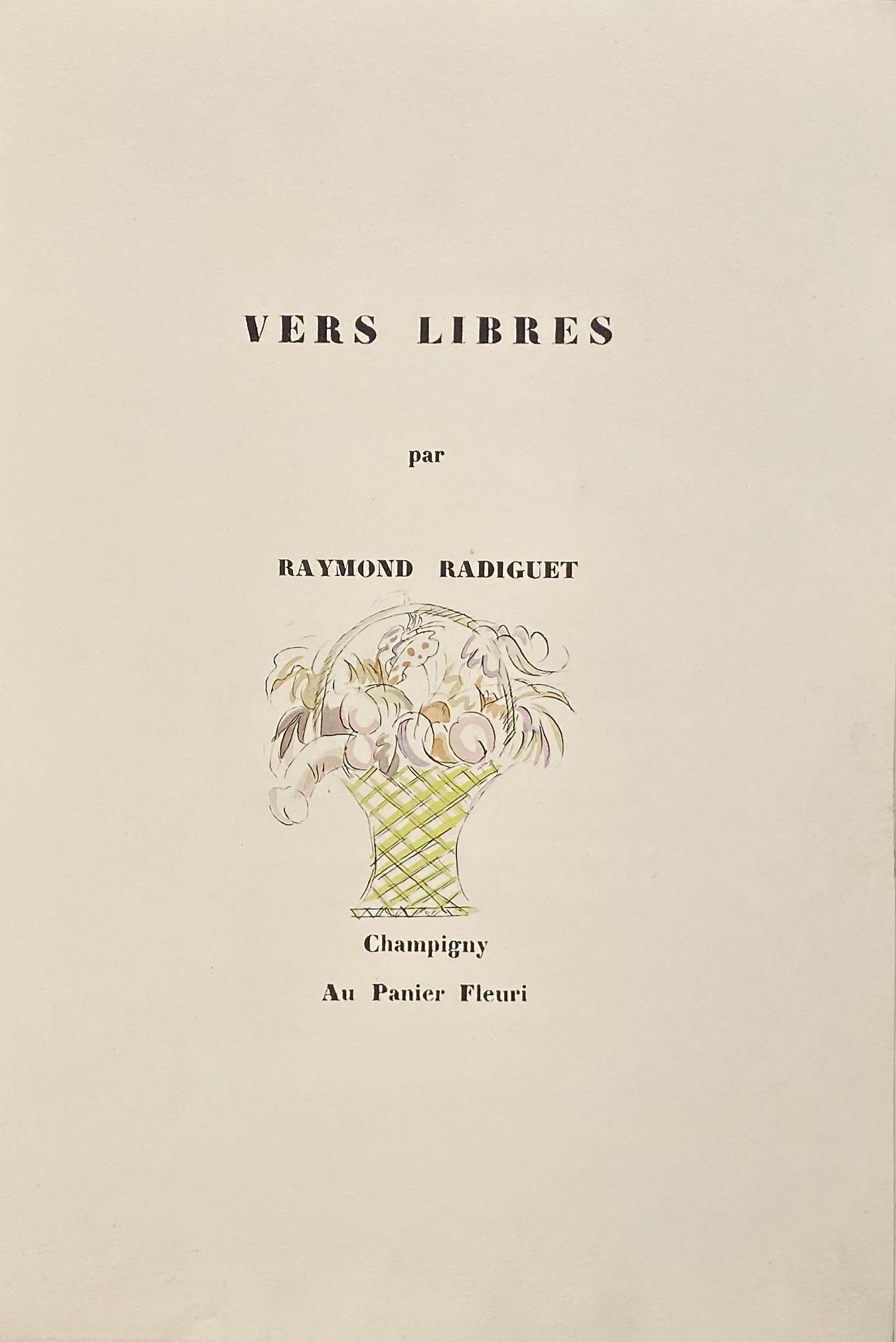
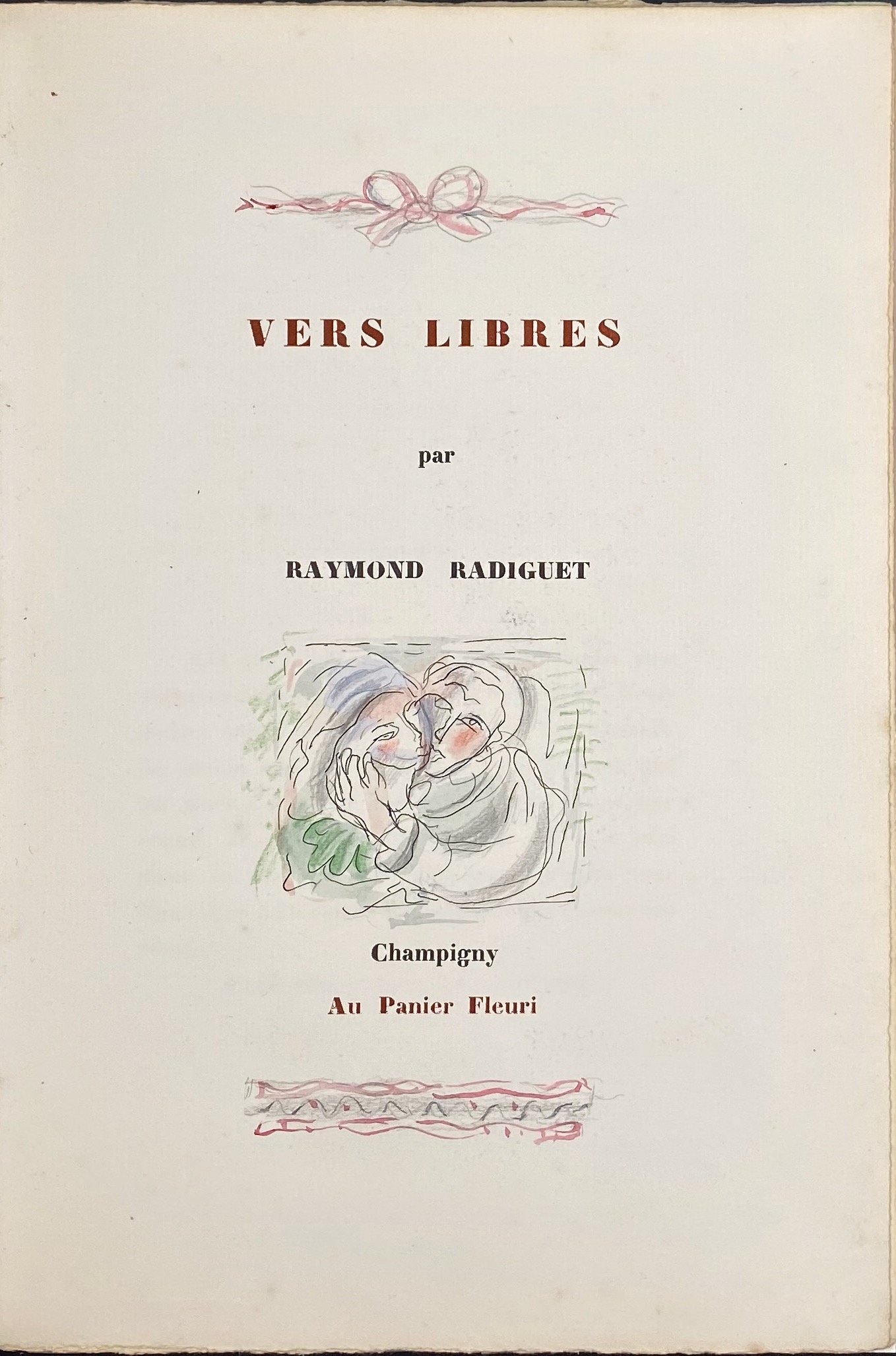
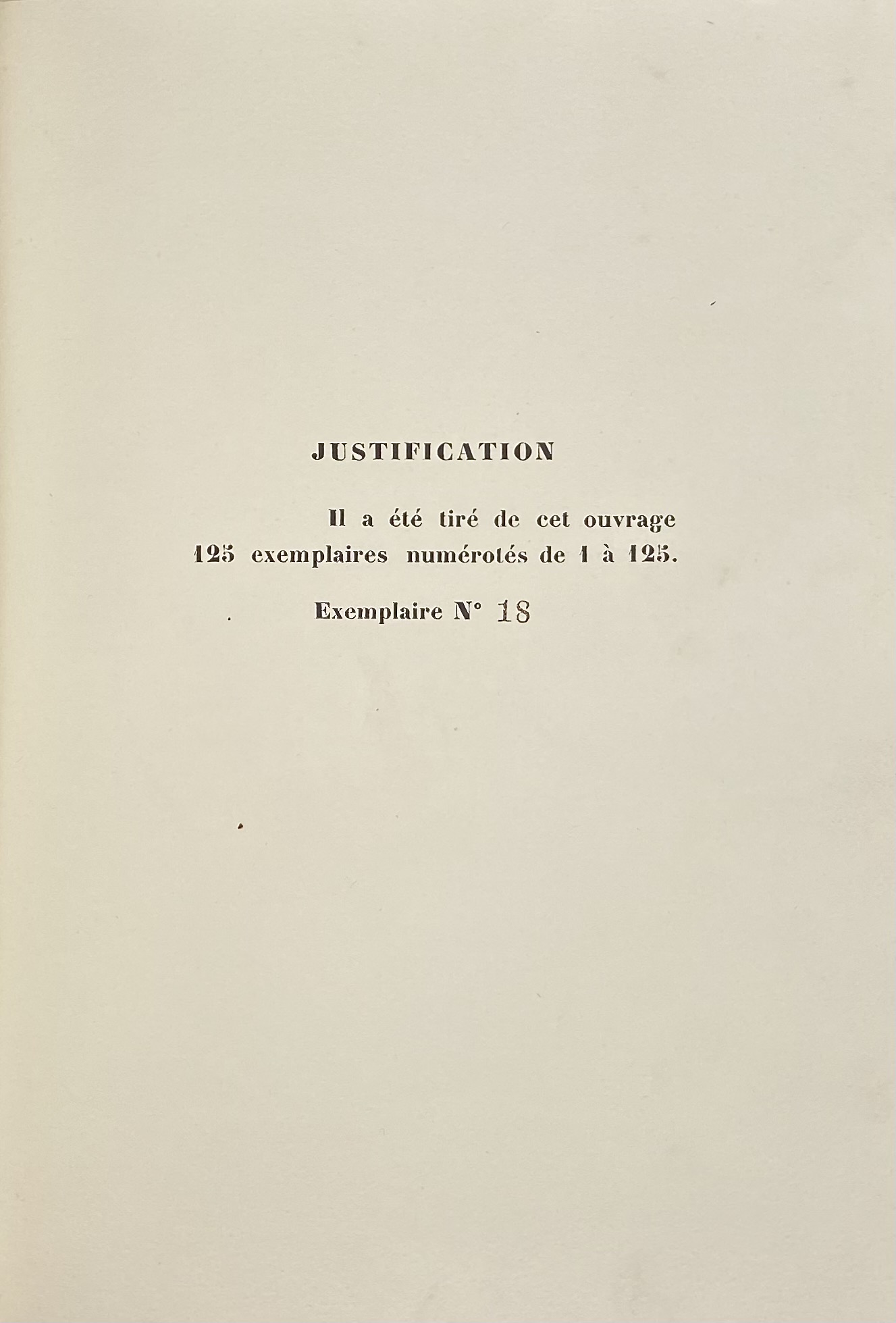
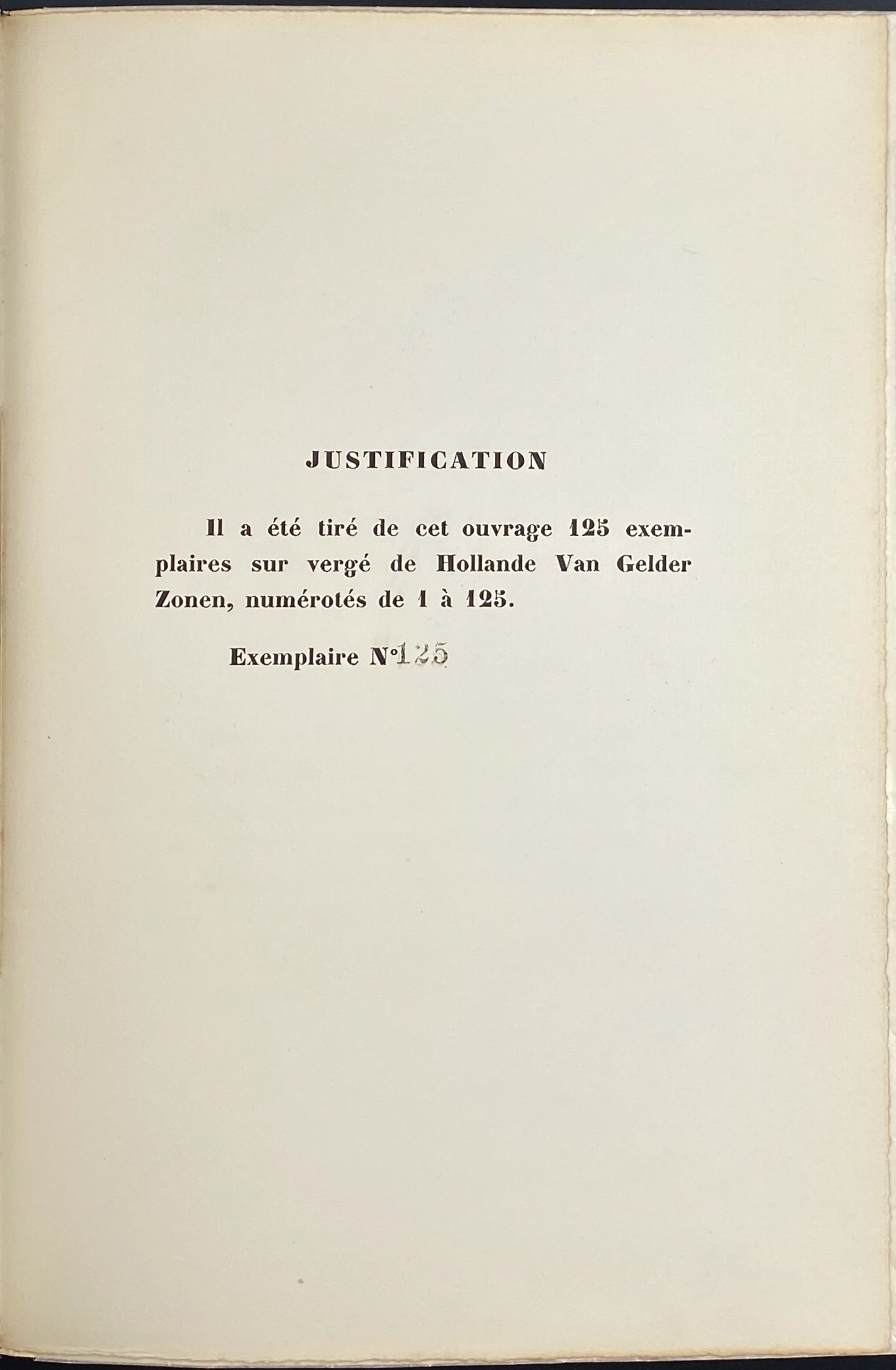
-
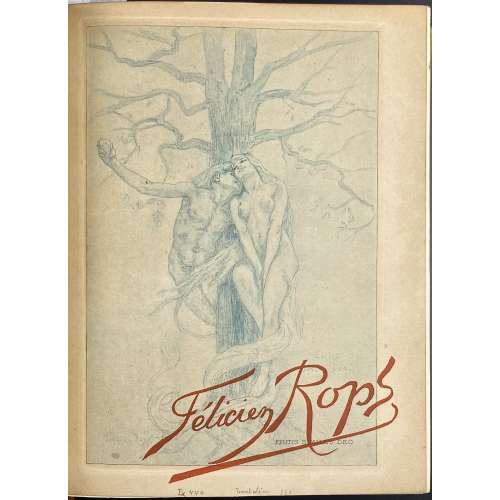 One volume in-4o, 26.5 x 21 x 4.4 cm, bound by Durvand (signed) in yellow ¾ morocco over marbled boards outlined in gilt, spine with raised bands, gilt lettering, vignettes after Félicien Rops in compartments, top margin gilt, marbled endpapers, publisher’s wrappers preserved; enriched with 57 original prints after Félicien Rops and an etched portrait of Félicien Rops by Robert Kastor. Collation: 3 blanks, π4 (orig. front wrapper ‘En souscription…./Etudes sur…’, La tentation…/Érastène Ramiro..., h.t./justification, t.p/blank), 1-274 (paginated 1-215 [216]) χ2 plus 58 leaves of bound-in original prints by various printers on different papers, some on India paper pasted on vergé, with tissue guards, and 1 leave of manuscript ‘Table de gravures dans le texte’; back wrapper with ‘Table des gravures ajoutées’ manuscript to recto, original spine, 2 blanks. Title-page (red and black): Études sur quelques Artistes originaux | — | FÉLICIEN ROPS | par | ÉRASTÈNE RAMIRO | {fleuron} | PARIS | (left): G. PELLET | 51, Rue Le Peletier, 51 | (right): H. FLOURY | 1, Boulevard des Capucines, 1 | 1905 || Limitation: 125 copies, of which 100 copies on Japon à la forme and 25 copies 0n papier de Chine. Photographs here represent the original prints only. Contributors: Eugène Rodrigues-Henriques [Eugène Rodrigues, Erastène Ramiro] (French, 1853 –1928) – author. Félicien Rops (Belgian, 1833 – 1898) – artist. Robert Kastor (French, 1872 – 1935) – artist. Imprimerie Charles Hérissey (Évreux) – printer Gustave Pellet (French, 1859 – 1919) – publisher. Henri Floury (French, 1862 –1961) – publisher. Lucien Durvand (French, 1852 – 1924) – bookbinder.
One volume in-4o, 26.5 x 21 x 4.4 cm, bound by Durvand (signed) in yellow ¾ morocco over marbled boards outlined in gilt, spine with raised bands, gilt lettering, vignettes after Félicien Rops in compartments, top margin gilt, marbled endpapers, publisher’s wrappers preserved; enriched with 57 original prints after Félicien Rops and an etched portrait of Félicien Rops by Robert Kastor. Collation: 3 blanks, π4 (orig. front wrapper ‘En souscription…./Etudes sur…’, La tentation…/Érastène Ramiro..., h.t./justification, t.p/blank), 1-274 (paginated 1-215 [216]) χ2 plus 58 leaves of bound-in original prints by various printers on different papers, some on India paper pasted on vergé, with tissue guards, and 1 leave of manuscript ‘Table de gravures dans le texte’; back wrapper with ‘Table des gravures ajoutées’ manuscript to recto, original spine, 2 blanks. Title-page (red and black): Études sur quelques Artistes originaux | — | FÉLICIEN ROPS | par | ÉRASTÈNE RAMIRO | {fleuron} | PARIS | (left): G. PELLET | 51, Rue Le Peletier, 51 | (right): H. FLOURY | 1, Boulevard des Capucines, 1 | 1905 || Limitation: 125 copies, of which 100 copies on Japon à la forme and 25 copies 0n papier de Chine. Photographs here represent the original prints only. Contributors: Eugène Rodrigues-Henriques [Eugène Rodrigues, Erastène Ramiro] (French, 1853 –1928) – author. Félicien Rops (Belgian, 1833 – 1898) – artist. Robert Kastor (French, 1872 – 1935) – artist. Imprimerie Charles Hérissey (Évreux) – printer Gustave Pellet (French, 1859 – 1919) – publisher. Henri Floury (French, 1862 –1961) – publisher. Lucien Durvand (French, 1852 – 1924) – bookbinder. -
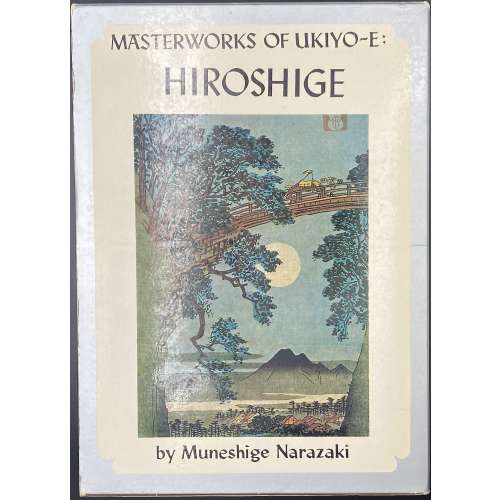 Hardcover volume from the series Masterworks of ukiyo-e, 26.3 x 19 cm, bound in unprimed canvas, red characters on black strip to front, red and black lettering to spine, tan flat endpapers, in a pictorial slipcase with series design (black lettering on silver spine); pp: [1-6]: h.t./frontis. (colour plate pasted in), t.p./imprint, contents/acknowledgements), 7-67 text, 27-30 map, 31-32 f.t./blank, 33-96 (65 plates w/captions). Title-page (in frame): MASTERWORKS OF UKIYO-E | HIROSHIGE | FAMOUS VIEWS | by Muneshige Narazaki | English adaptation by Richard L. Gage | {publisher’s device} | KODANSHA INTERNATIONAL LTD. | Tokyo, Japan & Palo-Alto, Calif., U.S.A | {vertical, between rules in ms 広重]} || Series: Masterworks of ukiyo-e, № 5. Edition: 1st edition ©1968, 2nd printing 1970. Muneshige Narazaki [楢崎 宗重] (Japanese, 1904 – 2001) – author. Utagawa Hiroshige [歌川 広重] a.k.a. Andō Hiroshige [安藤 広重] (Japanese, 1797 – 1858) – artist. Richard L. Gage (American, b. 1934) – adaptation.
Hardcover volume from the series Masterworks of ukiyo-e, 26.3 x 19 cm, bound in unprimed canvas, red characters on black strip to front, red and black lettering to spine, tan flat endpapers, in a pictorial slipcase with series design (black lettering on silver spine); pp: [1-6]: h.t./frontis. (colour plate pasted in), t.p./imprint, contents/acknowledgements), 7-67 text, 27-30 map, 31-32 f.t./blank, 33-96 (65 plates w/captions). Title-page (in frame): MASTERWORKS OF UKIYO-E | HIROSHIGE | FAMOUS VIEWS | by Muneshige Narazaki | English adaptation by Richard L. Gage | {publisher’s device} | KODANSHA INTERNATIONAL LTD. | Tokyo, Japan & Palo-Alto, Calif., U.S.A | {vertical, between rules in ms 広重]} || Series: Masterworks of ukiyo-e, № 5. Edition: 1st edition ©1968, 2nd printing 1970. Muneshige Narazaki [楢崎 宗重] (Japanese, 1904 – 2001) – author. Utagawa Hiroshige [歌川 広重] a.k.a. Andō Hiroshige [安藤 広重] (Japanese, 1797 – 1858) – artist. Richard L. Gage (American, b. 1934) – adaptation. -
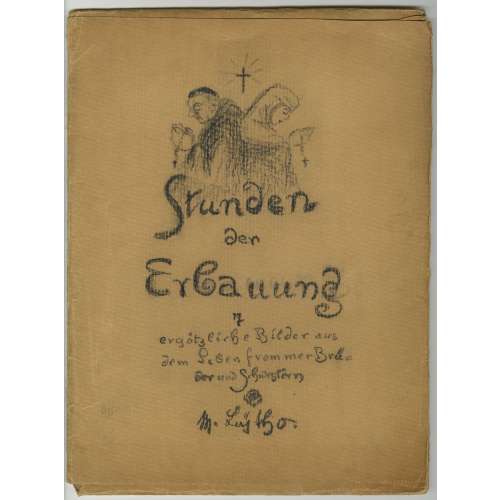 Flapped folder of thick embossed paper 353 x 263 mm, with a vignette and manuscript to front: Stunden der Erbauung | 7 | ergötz liebe Bilder aus | dem Leben frommer Brü | der und Schwestern | • | M. Leÿtho. ||, six graphite pencil drawings, each glued to a paper sheet with guard tissue; mat size 339 x 253 mm mat; drawing size 220 x 165 mm. Translation of the title: Hours of Edification / 7 delightful pictures from the lives of pious brothers and sisters. Information about the artist at www.honesterotica.com: "Mitja Leytho, almost certainly a pseudonym, is yet another mediocre yet fascinating amateur artist from the Germany of the 1920s about whom we know absolutely nothing beyond the four portfolios which bear the ‘Leytho’ signature".
Flapped folder of thick embossed paper 353 x 263 mm, with a vignette and manuscript to front: Stunden der Erbauung | 7 | ergötz liebe Bilder aus | dem Leben frommer Brü | der und Schwestern | • | M. Leÿtho. ||, six graphite pencil drawings, each glued to a paper sheet with guard tissue; mat size 339 x 253 mm mat; drawing size 220 x 165 mm. Translation of the title: Hours of Edification / 7 delightful pictures from the lives of pious brothers and sisters. Information about the artist at www.honesterotica.com: "Mitja Leytho, almost certainly a pseudonym, is yet another mediocre yet fascinating amateur artist from the Germany of the 1920s about whom we know absolutely nothing beyond the four portfolios which bear the ‘Leytho’ signature". -
 Colour (tone) lithography, image 396 x 508 mm, sheet 532 x 654 mm; before signature, undated; pencil ms inscription: Föhrenhain — E. Pelikan / 200M to the lower-right corner of the sheet. Contributor: Emilie Mediz-Pelikan (Austrian, 1861 – 1908) – artist. Seller's description: Austrian-German painter and graphic artist. Emilie Mediz-Pelikan was born in Vöcklabruck in 1861. She studied at the Vienna Academy and followed her teacher Albert Zimmermann to Salzburg and in 1885 to Munich. In 1891 she married the painter and graphic artist Karl Mediz (1868 - 1945), with whom she lived in Vienna and from 1894 in Dresden. She was in contact with the Dachau Artists' Colony and went on study trips to Paris, Belgium, Hungary and Italy. In the Dachau artists' colony she was friends with Adolf Hölzel and Fritz von Uhde. In 1889 and 1890 she spent time in Paris and in the Belgian artists' colony Knokke. In 1898 she was represented at the first art exhibition of the Vienna Secession, and in 1901 at the International Art Exhibition in Dresden. In 1903 she and her husband had a group exhibition, at the Hagenbund in Vienna. In 1904, she showed graphic works at the Dresden royal court art dealer Richter, and in 1905 and 1906 she exhibited at the Berlin Künstlerhaus. It was not until around 1900 that she achieved her artistic breakthrough with her landscape paintings. Since the estate of the artist, who died prematurely in Dresden in 1908, was lost in the former GDR until the 1980s, it was quite late that the artist was rediscovered and revalued both in Austrian art history and on the art market. In 1986, the first major exhibitions took place at the Upper Austrian State Museum and the University of Applied Arts in Vienna, followed by numerous smaller exhibitions in private galleries in Vienna, Linz and Munich. The artist received recognition during her lifetime from numerous prominent fellow painters as well as from the art critic Ludwig Hevesi. Together with Tina Blau, Herbert Boeckl, Marie Egner, Theodor von Hörmann, Franz Jaschke, Eugen Jettel, Ludwig Heinrich Jungnickel, Rudolf Junk, Gustav Klimt, Oskar Kokoschka, Johann Victor Krämer, Heinrich Kühn, Carl Moll, Rudolf Quittner, Rudolf Ribarz, Emil Jakob Schindler, Max Suppantschitsch, Max Weiler, Olga Wisinger-Florian and Alfred Zoff, she was a protagonist of the reception of Impressionism in Austria. This style went down in Austrian art history under the term "Stimmungsimpressionismus".
Colour (tone) lithography, image 396 x 508 mm, sheet 532 x 654 mm; before signature, undated; pencil ms inscription: Föhrenhain — E. Pelikan / 200M to the lower-right corner of the sheet. Contributor: Emilie Mediz-Pelikan (Austrian, 1861 – 1908) – artist. Seller's description: Austrian-German painter and graphic artist. Emilie Mediz-Pelikan was born in Vöcklabruck in 1861. She studied at the Vienna Academy and followed her teacher Albert Zimmermann to Salzburg and in 1885 to Munich. In 1891 she married the painter and graphic artist Karl Mediz (1868 - 1945), with whom she lived in Vienna and from 1894 in Dresden. She was in contact with the Dachau Artists' Colony and went on study trips to Paris, Belgium, Hungary and Italy. In the Dachau artists' colony she was friends with Adolf Hölzel and Fritz von Uhde. In 1889 and 1890 she spent time in Paris and in the Belgian artists' colony Knokke. In 1898 she was represented at the first art exhibition of the Vienna Secession, and in 1901 at the International Art Exhibition in Dresden. In 1903 she and her husband had a group exhibition, at the Hagenbund in Vienna. In 1904, she showed graphic works at the Dresden royal court art dealer Richter, and in 1905 and 1906 she exhibited at the Berlin Künstlerhaus. It was not until around 1900 that she achieved her artistic breakthrough with her landscape paintings. Since the estate of the artist, who died prematurely in Dresden in 1908, was lost in the former GDR until the 1980s, it was quite late that the artist was rediscovered and revalued both in Austrian art history and on the art market. In 1986, the first major exhibitions took place at the Upper Austrian State Museum and the University of Applied Arts in Vienna, followed by numerous smaller exhibitions in private galleries in Vienna, Linz and Munich. The artist received recognition during her lifetime from numerous prominent fellow painters as well as from the art critic Ludwig Hevesi. Together with Tina Blau, Herbert Boeckl, Marie Egner, Theodor von Hörmann, Franz Jaschke, Eugen Jettel, Ludwig Heinrich Jungnickel, Rudolf Junk, Gustav Klimt, Oskar Kokoschka, Johann Victor Krämer, Heinrich Kühn, Carl Moll, Rudolf Quittner, Rudolf Ribarz, Emil Jakob Schindler, Max Suppantschitsch, Max Weiler, Olga Wisinger-Florian and Alfred Zoff, she was a protagonist of the reception of Impressionism in Austria. This style went down in Austrian art history under the term "Stimmungsimpressionismus". -
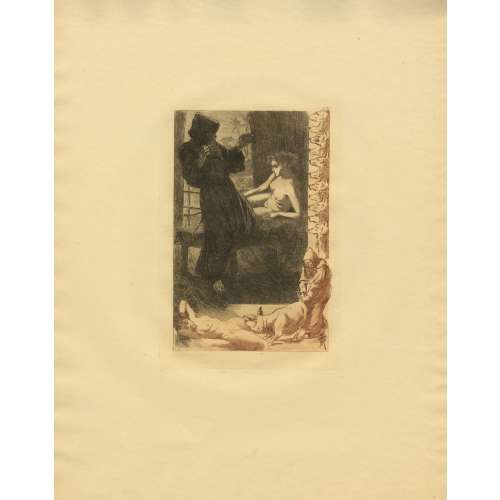 Set of 21 etchings by Martin van Maele for the English edition of ‘Thais’ by Anatole France published in London by Charles Carrington in 1901. Printed on vowe paper without a watermark in two colours with the black image and sepia historiated border. All etchings are inscribed with the artist's monogram; one of the etchings bears inscriptions ORGUEIL, LUXURE, DOUTE (mirror image). Dimensions: sheet: 317 x 250 mm; plate: 170 x 115 mm; image: 155 x 100 mm. Catalogue raisonné: S. A. Perry: № 64. Per Perry, the edition was printed in 500 copies on 'handmade paper watermarked 'Van Gelder'. Contributor: Martin van Maële [Martin, Maurice François Alfred] (French, 1863 – 1926)
Set of 21 etchings by Martin van Maele for the English edition of ‘Thais’ by Anatole France published in London by Charles Carrington in 1901. Printed on vowe paper without a watermark in two colours with the black image and sepia historiated border. All etchings are inscribed with the artist's monogram; one of the etchings bears inscriptions ORGUEIL, LUXURE, DOUTE (mirror image). Dimensions: sheet: 317 x 250 mm; plate: 170 x 115 mm; image: 155 x 100 mm. Catalogue raisonné: S. A. Perry: № 64. Per Perry, the edition was printed in 500 copies on 'handmade paper watermarked 'Van Gelder'. Contributor: Martin van Maële [Martin, Maurice François Alfred] (French, 1863 – 1926) -
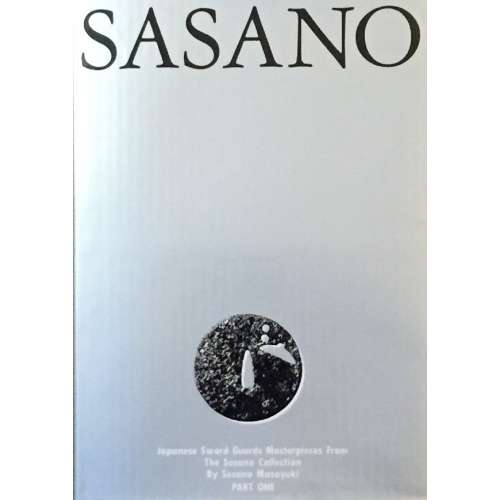
Sasano: Japanese Sword Guard Masterpieces from the Sasano Collection. By Sasano Masayuki. Part One. Published in Japan in 1994 by Daisuke Saito, Mega Co., Ltd. Translated by Tomoko Saro. Printed by Mitsumura Printing Co., Ltd. 304 x 217 x 30 mm
-
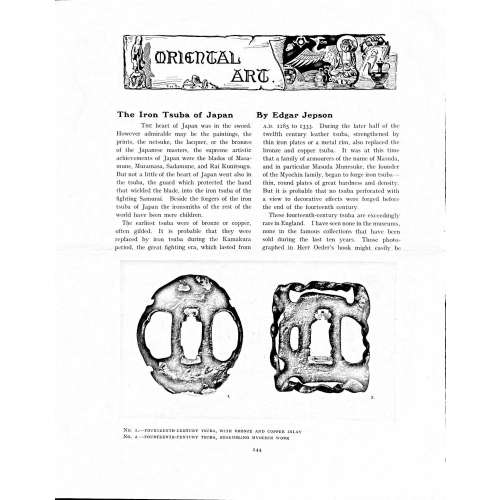 Magazine article by Edgar Jepson: The Iron Tsuba of Japan (Section: Oriental Art), published in volume Vol. 70 (September–December) of The Connoisseur: An Illustrated Magazine for Collectors, Vol. 70 (September–December); pp. 143-152 / C. Reginald Grundy [ed.] — London: Published by the Proprietor, W. CLAUSE JOHNSON, at the Editorial and Advertisement Offices of The Connoisseur, 1924. Owner's half black morocco, gilt lettering to spine, blue cloth boards. Two volumes bound together without original covers. Size 28.5 x 22 cm. Vol. 1: The Connoisseur | An Illustrated Magazine | For Collectors | Edited by C. Reginald Grundy | Vol. LXIX. | (MAY—AUGUST, 1924) | LONDON | Published by the Proprietor, W. CLAUSE JOHNSON, at the | Editorial and Advertisement Offices of The Connoisseur, | at 1, Duke Street, St. James's, S.W. 1 | 1924 || Pp.: [i-ii] iii-xviii [xix] [1, 2 - plate] 3-249 [250]. Vol. 2: The Connoisseur | An Illustrated Magazine | For Collectors | Edited by C. Reginald Grundy | Vol. LXX. | (SEPTEMBER—DECEMBER, 1924) | LONDON | Published by the Proprietor, W. CLAUSE JOHNSON, at the | Editorial and Advertisement Offices of The Connoisseur, | at 1, Duke Street, St. James's, S.W. 1 | 1924 || Pp.: [i-ii] iii-xxii [2 blanks] [1, 2 - plate] 3-261 [262]. The Iron Tsuba of Japan by Edgar Jepson The heart of Japan was in the sword. However admirable may be the paintings, the prints, the netsuke, the lacquer, or the bronzes of the Japanese masters, the supreme artistic achievements of Japan were the blades of Masamune, Muramasa, Sadamune, and Rai Kunitsugu. But not a little of the heart of Japan went also in the tsuba, the guard which protected the hand that wielded the blade, into the iron tsuba of the fighting Samurai. Beside the forgers of the iron tsuba of Japan the ironsmiths of the rest of the world have been mere children. The earliest tsuba were of bronze or copper, often gilded. It is probable that they were replaced by iron tsuba during the Kamakura period, the great fighting era, which lasted from A.D. 1185 to 1333. During the later half of the twelfth century leather tsuba, strengthened by thin iron plates or a metal rim, also replaced the bronze and copper tsuba. It was at this time that a family of armourers of the name of Masuda, and in particular Masuda Munesuke, the founder of the Myochin family, began to forge iron tsuba — thin, round plates of great hardness and density. But it is probable that no tsuba perforated with a view to decorative effects were forged before the end of the fourteenth century. These fourteenth-century tsuba are exceedingly rare in England. I have seen none in the museums, none in the famous collections that have been sold during the last ten years. Those photographed in Herr Oeder's book might easily be the fifteenth century. No. 1 is a curious cup-shape tsuba decorated with a bronze and copper inlay. No. 2, with its edges curiously twisted in the forging, looks like Myochin work. But it is not of the Myochin iron. The Myochin family produced some of the greatest ironsmiths of Japan. Armourers first of all, tsubasmiths, forgers of sake-kettles, articulated reptiles, crustacea, and insects — everything that can be done with iron they did; they pushed their medium to its limit. They were forging iron tsuba in 1160, and they were still forging them in 1860. And it was their own iron, or rather their own steel. They discovered the secret of it early, and they kept that secret in the family for all those hundreds of years. There is no mistaking a Myochin tsuba: balance it on your finger and tap it with a piece of metal, always it gives forth a clear bell-like ring that you get from the work of no other ironsmith, Japanese or European. Always the Myochin tsuba is before everything a protection to the hand of the swordsman; to that everything is, as it should be, subordinated. No. 3 is a Myochin tsuba of the fifteenth century, and probably of the early fifteenth century. No. 4, by Myochin Munetaka, perforated with a grotesque figure, is an example of that twisting and twisting of the iron in the forging till it forms a pattern like the grain of wood. The Myochin smiths invented these wood-grain tsuba, and no other smiths equalled them in their forging. In the sixteenth century, the fighting tsuba was probably at its best. It was a century of great tsubasmiths. Then the first Nobuiye, whose tsuba fetched £100 apiece, circa 1800, in Japan, and the first Kaneiye flourished. No. 5 is a tsuba forged by a great smith, Iyesada of Sotome, in the manner of Nobuiye I, decorated with the karakusa tendrils that Nobuiye delighted in, with lightning and clouds. No. 6 is a guard of Sanada Tembo, the chief smith of the Tembo family, stamped, punning fashion, with the character Tembo. Akin to the Tembo tsuba were those of the Kiami and Hoan smiths. Then also the Heianjo smiths and the Owari smiths, especially those of Nagoya and the Yamakichi family, forged their strongest tsuba. Those of the Yamakichi were tested after the forging by being pounded in iron mortars — at least, so the legend runs. But they were a sternly utilitarian family, and I have never seen a Yamakichi tsuba of any beauty. In the later half of the fifteenth century arose the fashion of decorating tsuba with an inlay, zogan, of bronze. The Heianjo tsuba, forged at Kyoto in the latter half of the fifteenth and the beginning of the sixteenth century, were often thus inlaid. The earliest of them were called "Onin", of which No. 7 is an example. In addition to the bronze inlay around the edge, it is inlaid with a representation, some say, of snow; others say, of the duckweed on a pond. No. 8 is probably a Heianjo tsuba, but I am not quite sure about it. The inlaid acacia branches might be very early Shoami work. But to judge by the iron, it is a fifteenth-century tsuba; and the authorities place the beginning of the Shoami school not later than early in the sixteenth century. No. 10 is an example of the Fushimi-zogan, a flat inlay of a light-coloured bronze. These tsuba took their name from the fact that they were first forged at Fushimi, in Yamashiro, in the sixteenth century. It is of the type known as Mon-zukashi, perforated with crests (mon) à jour. The Yoshiro-zogan tsuba were also first forged at Fushimi by Yoshiro Naomasa. They were distinguished from the Fushimi-zogan by the fact that their inlay was generally a little raised-not always-for the inlay of No. 9, a tsuba forged by a later nineteenth-century Yoshiro, is quite flat. It is an interesting tsuba, for, with its decoration grown florid and excessive, it marks the intermediate stage between the simple and delightful designs of the genuine fighting tsuba and the elaborate pictures in gold and silver on the tsuba of the eighteenth-century smiths of Awa and Kyoto, which have become mere ornaments of the goldsmith. The Gomoku-zogan (No. 11) tsuba were probably first forged earlier than the Fushimi and Yoshiro-zogan tsuba. This inlay, in slight relief, is a representation in a light-coloured bronze and copper of twigs caught in the eddies of streams. The seventeenth century and early eighteenth century were the great periods of perforated tsuba. The designs, and they are often admirable, are for the most part in plain fretwork; but they are also chased. No. 12, a crane under an acacia, is a tsuba of a Higo smith, great forgers of fighting tsuba during this period. These smiths also excelled in nunome zogan, a very thin gold and silver inlay, with which they further decorated their perforated guards. The smiths of the Umetada and Shoami families also forged iron tsuba during this period; but their designs, though sometimes pleasing enough, are rarely fine. The best work of Myoju Umetada is in sentoku, not iron. The Choshu smiths, coming later, surpass the perforated guards of both the Umetada and Shoami smiths in beauty of design. No. 13, a lotus in the round, not only fretwork, but also engraved, is a good example of the admirable balance they so often attained in their designs. It is a sufficiently realistic lotus, but yet of a delightful simplicity. In considerable contrast is No. 14, the dragon by Soheishi Soten — one of the only two authentic tsuba of his forging known — the first forger of hikone-bori tsuba, which were in extraordinary favour in Japan during the eighteenth century, and illustrated every important event in Japanese history. It is on the elaborate side, but fine, strong work, and an excellent guard to the hand, for the lighter and more open part, which gives the design its admirable balance, is on the inside, and not exposed to the full swing of an opponent's blade. A few years ago there was a tendency to decry the Namban tsuba as having sprung too directly from foreign sources. But though the original suggestion may have been Chinese, or, as some say, Portuguese, the Japanese made it entirely their own, as characteristically Japanese as anything can well be, but, it must be admitted, of a decadent period. The school took its rise at the beginning of the seventeenth century, and the early tsuba were forged of a specially hard iron, the Wootz, imported from Southern India. No. 15, the signs of the Zodiac, is an excellent tsuba from the fighting point of view. Both it and No. 16 are of quite charming, if elaborate, design, and both of them, with their delicate scroll-work, so astonishingly undercut, are the very last word in the work of the ironsmith-veritable iron lace. To return to the simpler perforated tsuba, the smiths of Akasaka, a suburb of Tokyo, produced probably the most charming designs. Their style derives considerably from the Higo smiths, and their earlier fighting tsuba are very like the Higo tsuba. But always their work was just a little lighter than that of the Higo smiths, and in the end they moved right away from them and became the forgers of very light guards indeed. No. 17, is a representation of the Hiyokudori, the fabulous double bird, in which were reincarnated the souls of the two lovers, Gompachi and Komurasaki; and No. 18, “the tsuba of a hundred ducks "— there are about forty — are characteristic designs of the school. In the work of the Akasaka smiths the balance, which makes the design of a good tsuba so admirable and delightful, attains its height. This admirable balance seems often to be obtained by a deliberate sacrifice of symmetry. About nine hundred and ninety-nine European ironsmiths out of a thousand would have made the right and left sides of the Hiyoku-dori line by line, and perforation by perforation, exactly alike; he would have cut out exactly as many ducks on the one side of “the tsuba of a hundred ducks” as on the other, and made each duck on the right side correspond exactly in position and attitude with a duck on the left side. By variations the tsubasmith attained a finer balance, almost a higher symmetry. No. 19, often called by collectors the "rose-window" tsuba, but really a stylised chrysanthemum, is a favourite design of the Akasaka smiths, but Hizen work and inlaid in the Hizen manner with gold nunome. No. 20 is a Satsuma tsuba of the middle period. The Satsuma smiths of the nineteenth century produced probably the most ornate of all the iron guards, for the most part calibashes and beans with their leaves and tendrils realistic in the extreme, but of charming design. Few crafts have been carried further than that of the tsubasmith; few crafts working in a difficult medium have handled more subjects with greater feeling for beauty or greater liveliness of fancy. It is interesting to note again and again how school influences school, and smith influences smith. But, as in all the applied arts, the finest tsuba were forged by men who never lost sight of the purpose of a tsuba, that it is before everything a protection to the hand, and never subjected that purpose to a passion for virtuosity. Illustrations: No 1. FOURTEENTH-CENTURY TSUBA, WITH BRONZE AND COPPER INLAY No. 2. FOURTEENTH-CENTURY TSUBA, RESEMBLING MYOCHIN WORK No. 3. MYOCHIN TSUBA, FIFTEENTH CENTURY No. 4. MYOCHIN TSUBA, NINETEENTH CENTURY No. 5. SIXTEENTH-CENTURY TSUBA No. 6. SIXTEENTH-CENTURY TSUBA BY IYESADA OF SOTOME BY SANADA TEMBO No. 7. ONIN TSUBA No. 8. HEIANJO (?) TSUBA No. 9. YOSHIRO TSUBA, NINETEENTH CENTURY No. 10. FUSHIMI-ZOGAN, NINETEENTH CENTURY No. 11.- GOMOKU-ZOGAN, SIXTEENTH CENTURY No. 12. HIGO TSUBA, SEVENTEENTH CENTURY No. 13. CHOSHU TSUBA, SEVENTEENTH CENTURY No. 14. SOTEN TSUBA, SEVENTEENTH CENTURY No. 15. NAMBAN TSUBA, EIGHTEENTH CENTURY No. 16. NAMBAN TSUBA, NINETEENTH CENTURY Nos. 17. AND 18. AKASAKA TSUBA, EIGHTEENTH CENTURY No. 19. HIZEN TSUBA, EIGHTEENTH CENTURY No. 20. SATSUMA TSUBA, EIGHTEENTH CENTURY
Magazine article by Edgar Jepson: The Iron Tsuba of Japan (Section: Oriental Art), published in volume Vol. 70 (September–December) of The Connoisseur: An Illustrated Magazine for Collectors, Vol. 70 (September–December); pp. 143-152 / C. Reginald Grundy [ed.] — London: Published by the Proprietor, W. CLAUSE JOHNSON, at the Editorial and Advertisement Offices of The Connoisseur, 1924. Owner's half black morocco, gilt lettering to spine, blue cloth boards. Two volumes bound together without original covers. Size 28.5 x 22 cm. Vol. 1: The Connoisseur | An Illustrated Magazine | For Collectors | Edited by C. Reginald Grundy | Vol. LXIX. | (MAY—AUGUST, 1924) | LONDON | Published by the Proprietor, W. CLAUSE JOHNSON, at the | Editorial and Advertisement Offices of The Connoisseur, | at 1, Duke Street, St. James's, S.W. 1 | 1924 || Pp.: [i-ii] iii-xviii [xix] [1, 2 - plate] 3-249 [250]. Vol. 2: The Connoisseur | An Illustrated Magazine | For Collectors | Edited by C. Reginald Grundy | Vol. LXX. | (SEPTEMBER—DECEMBER, 1924) | LONDON | Published by the Proprietor, W. CLAUSE JOHNSON, at the | Editorial and Advertisement Offices of The Connoisseur, | at 1, Duke Street, St. James's, S.W. 1 | 1924 || Pp.: [i-ii] iii-xxii [2 blanks] [1, 2 - plate] 3-261 [262]. The Iron Tsuba of Japan by Edgar Jepson The heart of Japan was in the sword. However admirable may be the paintings, the prints, the netsuke, the lacquer, or the bronzes of the Japanese masters, the supreme artistic achievements of Japan were the blades of Masamune, Muramasa, Sadamune, and Rai Kunitsugu. But not a little of the heart of Japan went also in the tsuba, the guard which protected the hand that wielded the blade, into the iron tsuba of the fighting Samurai. Beside the forgers of the iron tsuba of Japan the ironsmiths of the rest of the world have been mere children. The earliest tsuba were of bronze or copper, often gilded. It is probable that they were replaced by iron tsuba during the Kamakura period, the great fighting era, which lasted from A.D. 1185 to 1333. During the later half of the twelfth century leather tsuba, strengthened by thin iron plates or a metal rim, also replaced the bronze and copper tsuba. It was at this time that a family of armourers of the name of Masuda, and in particular Masuda Munesuke, the founder of the Myochin family, began to forge iron tsuba — thin, round plates of great hardness and density. But it is probable that no tsuba perforated with a view to decorative effects were forged before the end of the fourteenth century. These fourteenth-century tsuba are exceedingly rare in England. I have seen none in the museums, none in the famous collections that have been sold during the last ten years. Those photographed in Herr Oeder's book might easily be the fifteenth century. No. 1 is a curious cup-shape tsuba decorated with a bronze and copper inlay. No. 2, with its edges curiously twisted in the forging, looks like Myochin work. But it is not of the Myochin iron. The Myochin family produced some of the greatest ironsmiths of Japan. Armourers first of all, tsubasmiths, forgers of sake-kettles, articulated reptiles, crustacea, and insects — everything that can be done with iron they did; they pushed their medium to its limit. They were forging iron tsuba in 1160, and they were still forging them in 1860. And it was their own iron, or rather their own steel. They discovered the secret of it early, and they kept that secret in the family for all those hundreds of years. There is no mistaking a Myochin tsuba: balance it on your finger and tap it with a piece of metal, always it gives forth a clear bell-like ring that you get from the work of no other ironsmith, Japanese or European. Always the Myochin tsuba is before everything a protection to the hand of the swordsman; to that everything is, as it should be, subordinated. No. 3 is a Myochin tsuba of the fifteenth century, and probably of the early fifteenth century. No. 4, by Myochin Munetaka, perforated with a grotesque figure, is an example of that twisting and twisting of the iron in the forging till it forms a pattern like the grain of wood. The Myochin smiths invented these wood-grain tsuba, and no other smiths equalled them in their forging. In the sixteenth century, the fighting tsuba was probably at its best. It was a century of great tsubasmiths. Then the first Nobuiye, whose tsuba fetched £100 apiece, circa 1800, in Japan, and the first Kaneiye flourished. No. 5 is a tsuba forged by a great smith, Iyesada of Sotome, in the manner of Nobuiye I, decorated with the karakusa tendrils that Nobuiye delighted in, with lightning and clouds. No. 6 is a guard of Sanada Tembo, the chief smith of the Tembo family, stamped, punning fashion, with the character Tembo. Akin to the Tembo tsuba were those of the Kiami and Hoan smiths. Then also the Heianjo smiths and the Owari smiths, especially those of Nagoya and the Yamakichi family, forged their strongest tsuba. Those of the Yamakichi were tested after the forging by being pounded in iron mortars — at least, so the legend runs. But they were a sternly utilitarian family, and I have never seen a Yamakichi tsuba of any beauty. In the later half of the fifteenth century arose the fashion of decorating tsuba with an inlay, zogan, of bronze. The Heianjo tsuba, forged at Kyoto in the latter half of the fifteenth and the beginning of the sixteenth century, were often thus inlaid. The earliest of them were called "Onin", of which No. 7 is an example. In addition to the bronze inlay around the edge, it is inlaid with a representation, some say, of snow; others say, of the duckweed on a pond. No. 8 is probably a Heianjo tsuba, but I am not quite sure about it. The inlaid acacia branches might be very early Shoami work. But to judge by the iron, it is a fifteenth-century tsuba; and the authorities place the beginning of the Shoami school not later than early in the sixteenth century. No. 10 is an example of the Fushimi-zogan, a flat inlay of a light-coloured bronze. These tsuba took their name from the fact that they were first forged at Fushimi, in Yamashiro, in the sixteenth century. It is of the type known as Mon-zukashi, perforated with crests (mon) à jour. The Yoshiro-zogan tsuba were also first forged at Fushimi by Yoshiro Naomasa. They were distinguished from the Fushimi-zogan by the fact that their inlay was generally a little raised-not always-for the inlay of No. 9, a tsuba forged by a later nineteenth-century Yoshiro, is quite flat. It is an interesting tsuba, for, with its decoration grown florid and excessive, it marks the intermediate stage between the simple and delightful designs of the genuine fighting tsuba and the elaborate pictures in gold and silver on the tsuba of the eighteenth-century smiths of Awa and Kyoto, which have become mere ornaments of the goldsmith. The Gomoku-zogan (No. 11) tsuba were probably first forged earlier than the Fushimi and Yoshiro-zogan tsuba. This inlay, in slight relief, is a representation in a light-coloured bronze and copper of twigs caught in the eddies of streams. The seventeenth century and early eighteenth century were the great periods of perforated tsuba. The designs, and they are often admirable, are for the most part in plain fretwork; but they are also chased. No. 12, a crane under an acacia, is a tsuba of a Higo smith, great forgers of fighting tsuba during this period. These smiths also excelled in nunome zogan, a very thin gold and silver inlay, with which they further decorated their perforated guards. The smiths of the Umetada and Shoami families also forged iron tsuba during this period; but their designs, though sometimes pleasing enough, are rarely fine. The best work of Myoju Umetada is in sentoku, not iron. The Choshu smiths, coming later, surpass the perforated guards of both the Umetada and Shoami smiths in beauty of design. No. 13, a lotus in the round, not only fretwork, but also engraved, is a good example of the admirable balance they so often attained in their designs. It is a sufficiently realistic lotus, but yet of a delightful simplicity. In considerable contrast is No. 14, the dragon by Soheishi Soten — one of the only two authentic tsuba of his forging known — the first forger of hikone-bori tsuba, which were in extraordinary favour in Japan during the eighteenth century, and illustrated every important event in Japanese history. It is on the elaborate side, but fine, strong work, and an excellent guard to the hand, for the lighter and more open part, which gives the design its admirable balance, is on the inside, and not exposed to the full swing of an opponent's blade. A few years ago there was a tendency to decry the Namban tsuba as having sprung too directly from foreign sources. But though the original suggestion may have been Chinese, or, as some say, Portuguese, the Japanese made it entirely their own, as characteristically Japanese as anything can well be, but, it must be admitted, of a decadent period. The school took its rise at the beginning of the seventeenth century, and the early tsuba were forged of a specially hard iron, the Wootz, imported from Southern India. No. 15, the signs of the Zodiac, is an excellent tsuba from the fighting point of view. Both it and No. 16 are of quite charming, if elaborate, design, and both of them, with their delicate scroll-work, so astonishingly undercut, are the very last word in the work of the ironsmith-veritable iron lace. To return to the simpler perforated tsuba, the smiths of Akasaka, a suburb of Tokyo, produced probably the most charming designs. Their style derives considerably from the Higo smiths, and their earlier fighting tsuba are very like the Higo tsuba. But always their work was just a little lighter than that of the Higo smiths, and in the end they moved right away from them and became the forgers of very light guards indeed. No. 17, is a representation of the Hiyokudori, the fabulous double bird, in which were reincarnated the souls of the two lovers, Gompachi and Komurasaki; and No. 18, “the tsuba of a hundred ducks "— there are about forty — are characteristic designs of the school. In the work of the Akasaka smiths the balance, which makes the design of a good tsuba so admirable and delightful, attains its height. This admirable balance seems often to be obtained by a deliberate sacrifice of symmetry. About nine hundred and ninety-nine European ironsmiths out of a thousand would have made the right and left sides of the Hiyoku-dori line by line, and perforation by perforation, exactly alike; he would have cut out exactly as many ducks on the one side of “the tsuba of a hundred ducks” as on the other, and made each duck on the right side correspond exactly in position and attitude with a duck on the left side. By variations the tsubasmith attained a finer balance, almost a higher symmetry. No. 19, often called by collectors the "rose-window" tsuba, but really a stylised chrysanthemum, is a favourite design of the Akasaka smiths, but Hizen work and inlaid in the Hizen manner with gold nunome. No. 20 is a Satsuma tsuba of the middle period. The Satsuma smiths of the nineteenth century produced probably the most ornate of all the iron guards, for the most part calibashes and beans with their leaves and tendrils realistic in the extreme, but of charming design. Few crafts have been carried further than that of the tsubasmith; few crafts working in a difficult medium have handled more subjects with greater feeling for beauty or greater liveliness of fancy. It is interesting to note again and again how school influences school, and smith influences smith. But, as in all the applied arts, the finest tsuba were forged by men who never lost sight of the purpose of a tsuba, that it is before everything a protection to the hand, and never subjected that purpose to a passion for virtuosity. Illustrations: No 1. FOURTEENTH-CENTURY TSUBA, WITH BRONZE AND COPPER INLAY No. 2. FOURTEENTH-CENTURY TSUBA, RESEMBLING MYOCHIN WORK No. 3. MYOCHIN TSUBA, FIFTEENTH CENTURY No. 4. MYOCHIN TSUBA, NINETEENTH CENTURY No. 5. SIXTEENTH-CENTURY TSUBA No. 6. SIXTEENTH-CENTURY TSUBA BY IYESADA OF SOTOME BY SANADA TEMBO No. 7. ONIN TSUBA No. 8. HEIANJO (?) TSUBA No. 9. YOSHIRO TSUBA, NINETEENTH CENTURY No. 10. FUSHIMI-ZOGAN, NINETEENTH CENTURY No. 11.- GOMOKU-ZOGAN, SIXTEENTH CENTURY No. 12. HIGO TSUBA, SEVENTEENTH CENTURY No. 13. CHOSHU TSUBA, SEVENTEENTH CENTURY No. 14. SOTEN TSUBA, SEVENTEENTH CENTURY No. 15. NAMBAN TSUBA, EIGHTEENTH CENTURY No. 16. NAMBAN TSUBA, NINETEENTH CENTURY Nos. 17. AND 18. AKASAKA TSUBA, EIGHTEENTH CENTURY No. 19. HIZEN TSUBA, EIGHTEENTH CENTURY No. 20. SATSUMA TSUBA, EIGHTEENTH CENTURY -
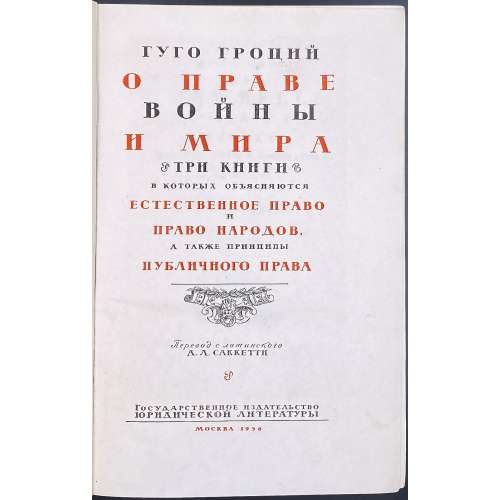 Title page (black and red): ГУГО ГРОЦИЙ | О ПРАВЕ | ВОЙНЫ | И МИРА | ß ТРИ КНИГИ ß | В КОТОРЫХ ОБЪЯСНЯЮТСЯ | ЕСТЕСТВЕННОЕ ПРАВО | И | ПРАВО НАРОДОВ, | А ТАКЖЕ ПРИНЦИПЫ | ПУБЛИЧНОГО ПРАВА | {device} | Перевод с латинского | А. Л. САККЕТТИ | Государственное издательство | ЮРИДИЧЕСКОЙ ЛИТЕРАТУРЫ | МОСКВА 1956 || Verso t.p.: Под общей редакцией профессора С. Б. КРЫЛОВА Pagination: [1, 2] – t.p. / editor, [3] 4-867 [868] – contents, errata slip, 4 plates extraneous to collation: frontis. portrait, t.p. Amsterdam edition of 1646, t.p. Russian edition of c. 1710, Lovensteyn castle. Collation: 8vo; [1]8 2-548 552. Binding: Publisher’s brown cloth, blind-stamped lettering to front board, elements of design in black and gilt lettering to spine. Вступительная статья А. А. Желудкова. Author: Hugo Grotius [Huig or Hugo de Groot] (Dutch, 1583 – 1645). Originally published by Nicolas Buon in Paris in 1625 in Latin under the title: De iure belli ac pacis (English: On the Law of War and Peace). Editor: Сергей Борисович Крылов (Russian, 1888 – 1958). Translator: Александр Ливериевич Саккетти (Russian, 1881 – 1966).
Title page (black and red): ГУГО ГРОЦИЙ | О ПРАВЕ | ВОЙНЫ | И МИРА | ß ТРИ КНИГИ ß | В КОТОРЫХ ОБЪЯСНЯЮТСЯ | ЕСТЕСТВЕННОЕ ПРАВО | И | ПРАВО НАРОДОВ, | А ТАКЖЕ ПРИНЦИПЫ | ПУБЛИЧНОГО ПРАВА | {device} | Перевод с латинского | А. Л. САККЕТТИ | Государственное издательство | ЮРИДИЧЕСКОЙ ЛИТЕРАТУРЫ | МОСКВА 1956 || Verso t.p.: Под общей редакцией профессора С. Б. КРЫЛОВА Pagination: [1, 2] – t.p. / editor, [3] 4-867 [868] – contents, errata slip, 4 plates extraneous to collation: frontis. portrait, t.p. Amsterdam edition of 1646, t.p. Russian edition of c. 1710, Lovensteyn castle. Collation: 8vo; [1]8 2-548 552. Binding: Publisher’s brown cloth, blind-stamped lettering to front board, elements of design in black and gilt lettering to spine. Вступительная статья А. А. Желудкова. Author: Hugo Grotius [Huig or Hugo de Groot] (Dutch, 1583 – 1645). Originally published by Nicolas Buon in Paris in 1625 in Latin under the title: De iure belli ac pacis (English: On the Law of War and Peace). Editor: Сергей Борисович Крылов (Russian, 1888 – 1958). Translator: Александр Ливериевич Саккетти (Russian, 1881 – 1966). -
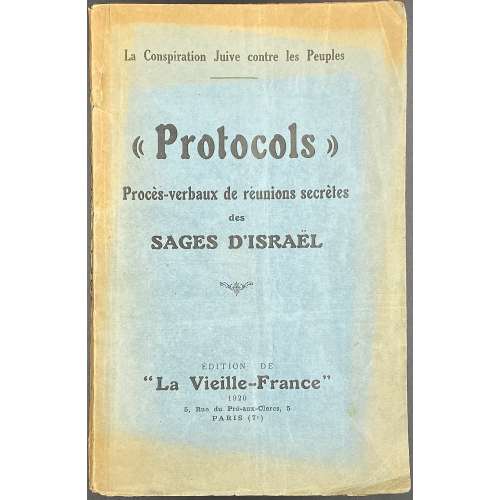 Cover: La Conspiration Juive contre les Peuples | « Protocols » | Procès-verbaux de réunions secrètes | des | SAGES D'ISRAËL | ÉDITION DE | “La Vieille-France” | 1920 | 5Rue du Pré-aux-Clercs, 5 | PARIS (7e) || Title: « Protocols » | Procès-verbaux de réunions secrètes | des | SAGES D'ISRAËL | ÉDITION DE | “La Vieille-France” | 1920 | 5Rue du Pré-aux-Clercs, 5 | PARIS (7e) || Pagination: [1, 2] – t.p. / blank, 3-141 [142 blank] [2] – table / blank. Pp.: 1-11 – Introduction; 13-82 – Protocols; 97-141 – Le Bolchevisme, c’est les Juifs. Collation : 8vo; [1]8 2-98. Binding: Publisher’s blue black-lettered wrappers, lettered spine. Printer: Imprimerie Chantenay (Paris). The French translation of "Протоколы синоских мудрецов" written in Russian by Сергей Нилус (Sergei Nilus, 1862 – 1929) was published in “La Vieille-France” by Urbain Gohier (1862 – 1951). Inside front wrapper: "Brave French! Please note that the format of this book allows you to hide it in your pockets. Your Jewish masters strictly forbid you to read it. Its existence is hidden in every possible way by the Jewish-controlled press. But fear not! While carefully hiding it, read carefully about what your Jewish masters forbid the newspapers to tell you. And you will understand – who and how will take your homeland away from you."
Cover: La Conspiration Juive contre les Peuples | « Protocols » | Procès-verbaux de réunions secrètes | des | SAGES D'ISRAËL | ÉDITION DE | “La Vieille-France” | 1920 | 5Rue du Pré-aux-Clercs, 5 | PARIS (7e) || Title: « Protocols » | Procès-verbaux de réunions secrètes | des | SAGES D'ISRAËL | ÉDITION DE | “La Vieille-France” | 1920 | 5Rue du Pré-aux-Clercs, 5 | PARIS (7e) || Pagination: [1, 2] – t.p. / blank, 3-141 [142 blank] [2] – table / blank. Pp.: 1-11 – Introduction; 13-82 – Protocols; 97-141 – Le Bolchevisme, c’est les Juifs. Collation : 8vo; [1]8 2-98. Binding: Publisher’s blue black-lettered wrappers, lettered spine. Printer: Imprimerie Chantenay (Paris). The French translation of "Протоколы синоских мудрецов" written in Russian by Сергей Нилус (Sergei Nilus, 1862 – 1929) was published in “La Vieille-France” by Urbain Gohier (1862 – 1951). Inside front wrapper: "Brave French! Please note that the format of this book allows you to hide it in your pockets. Your Jewish masters strictly forbid you to read it. Its existence is hidden in every possible way by the Jewish-controlled press. But fear not! While carefully hiding it, read carefully about what your Jewish masters forbid the newspapers to tell you. And you will understand – who and how will take your homeland away from you." -
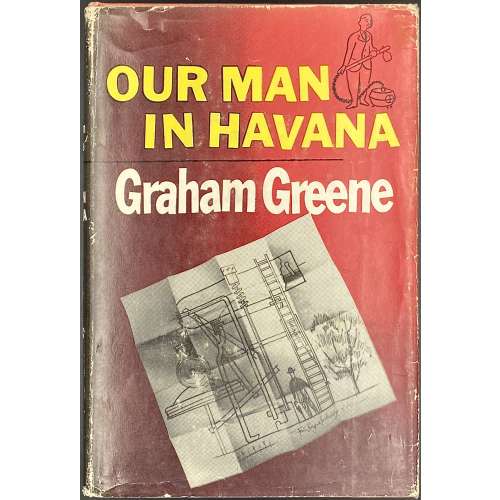 Title page: GRAHAM GREENE | {double rule} | Our Man | in Havana | AN ENTERTAINMENT | {citation: “And the sad man is cock of all his jests.” | — GEORGE HERBERT } | 1958 | THE VIKING PRESS • NEW YORK || Title verso: (top) COPYRIGHT © BY WILLIAM HEINEMANN LIMITED | PUBLISHED IN 1958 BY THE VIKING PRESS, INC. | 625 MADISON AVENUE, NEW YORK 22, N. Y. | (bottom) {publisher’s device} | LIBRARY OF CONGRESS CATALOGUE CARD NUMBER: 58.11735 | PRINTED IN THE U. S. A. BY | AMERICAN BOOK – STRATFORD PRESS || Pagination: [6] [1, 2] 3-273 [274]. Binding: 21 x 14 cm, publisher’s pink cloth, black lettering to spine: {double rule} | GRAHAM GREENE | Our | Man | in | Havana | VIKING | {double rule} ||; black vignette to front cover in the lower-right corner; original pictorial dust jacket designed by Bill English, unclipped, $3.50 in the upper-right corner of the front flap, advertisement “Also by Graham Greene” on the back flap. Edition: 1st American edition. Contributors: Henry Graham Greene (British, 1904 – 1991) – author. Bill English (British, b. 1931) – artist. The Viking Press, NY (1925 – 1975) – publisher. American Book-Stratford Press, Inc. – printer.
Title page: GRAHAM GREENE | {double rule} | Our Man | in Havana | AN ENTERTAINMENT | {citation: “And the sad man is cock of all his jests.” | — GEORGE HERBERT } | 1958 | THE VIKING PRESS • NEW YORK || Title verso: (top) COPYRIGHT © BY WILLIAM HEINEMANN LIMITED | PUBLISHED IN 1958 BY THE VIKING PRESS, INC. | 625 MADISON AVENUE, NEW YORK 22, N. Y. | (bottom) {publisher’s device} | LIBRARY OF CONGRESS CATALOGUE CARD NUMBER: 58.11735 | PRINTED IN THE U. S. A. BY | AMERICAN BOOK – STRATFORD PRESS || Pagination: [6] [1, 2] 3-273 [274]. Binding: 21 x 14 cm, publisher’s pink cloth, black lettering to spine: {double rule} | GRAHAM GREENE | Our | Man | in | Havana | VIKING | {double rule} ||; black vignette to front cover in the lower-right corner; original pictorial dust jacket designed by Bill English, unclipped, $3.50 in the upper-right corner of the front flap, advertisement “Also by Graham Greene” on the back flap. Edition: 1st American edition. Contributors: Henry Graham Greene (British, 1904 – 1991) – author. Bill English (British, b. 1931) – artist. The Viking Press, NY (1925 – 1975) – publisher. American Book-Stratford Press, Inc. – printer. -
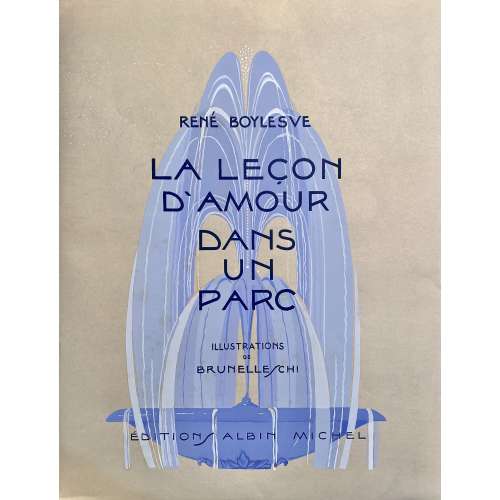 Title page (blue and black): RENE BOYLESVE | LA | LEÇON D'AMOUR | DANS UN PARC | ILLUSTRATIONS EN COULEURS | DE | BRUNELLESCHI | PARIS | ÉDITIONS ALBIN MICHEL | 22, RUE HUYGHENS (14e) || Pagination: [6] 1-173 [174] [4], total 184 pages, ils. Collation: publisher’s pictorial wrappers with 2 blank leaves – front and back, π2 (h.t. / justification, t.p. / blank), 87 leaves of text, [1] colophon / blank, total 92 leaves plus 21 plates, incl. frontispiece. Binding: 33.5 x 26 cm; original flapped wrappers, blue fountain and lettering to front, lettering to spine, back blank, in a marbled buckram folder (33.5 x 27 cm) with lettered paper label to spine; printed on Arches wove paper, margins untrimmed. Illustrations: 42 vignettes, tail- and headpieces in color, frontispiece and 20 plates after watercolours and gouaches by Umberto Brunelleschi printed in black and stencil-coloured (au pochoir) on the 18th of November 1933 at R. Coulouma press (Argenteuil), Jacomet press and Padovani press. Contributors: René Boylesve [Tardiveau] (French, 1867 – 1926) – author. Umberto Brunelleschi (Italian, 1879 – 1949) – artist. Daniel Jacomet (French, b. 1894 – ?) – printer. Imprimerie Coulouma (Argenteuil), Robert Coulouma (French, 1887-1976) – printer. Éditions Albin Michel (Paris) ; Albin Michel (French, 1873 – 1943) – publisher. First edition of René Boylesve's novel La Leçon d’amour dans un parc was conducted in Paris by Éditions de la Revue Blanche, in 1902. Description of the stensil (au pochoir) technique.
Title page (blue and black): RENE BOYLESVE | LA | LEÇON D'AMOUR | DANS UN PARC | ILLUSTRATIONS EN COULEURS | DE | BRUNELLESCHI | PARIS | ÉDITIONS ALBIN MICHEL | 22, RUE HUYGHENS (14e) || Pagination: [6] 1-173 [174] [4], total 184 pages, ils. Collation: publisher’s pictorial wrappers with 2 blank leaves – front and back, π2 (h.t. / justification, t.p. / blank), 87 leaves of text, [1] colophon / blank, total 92 leaves plus 21 plates, incl. frontispiece. Binding: 33.5 x 26 cm; original flapped wrappers, blue fountain and lettering to front, lettering to spine, back blank, in a marbled buckram folder (33.5 x 27 cm) with lettered paper label to spine; printed on Arches wove paper, margins untrimmed. Illustrations: 42 vignettes, tail- and headpieces in color, frontispiece and 20 plates after watercolours and gouaches by Umberto Brunelleschi printed in black and stencil-coloured (au pochoir) on the 18th of November 1933 at R. Coulouma press (Argenteuil), Jacomet press and Padovani press. Contributors: René Boylesve [Tardiveau] (French, 1867 – 1926) – author. Umberto Brunelleschi (Italian, 1879 – 1949) – artist. Daniel Jacomet (French, b. 1894 – ?) – printer. Imprimerie Coulouma (Argenteuil), Robert Coulouma (French, 1887-1976) – printer. Éditions Albin Michel (Paris) ; Albin Michel (French, 1873 – 1943) – publisher. First edition of René Boylesve's novel La Leçon d’amour dans un parc was conducted in Paris by Éditions de la Revue Blanche, in 1902. Description of the stensil (au pochoir) technique.


